Square and Shopify are two big names in the world of ecommerce but which one is the best for building an online store?
To answer this, we have done an in-depth comparison of the two platforms to see which one comes out on top.
EcommerceGold is reader supported and we may earn a commission from products or services purchased through links on our site at no additional cost to you, to learn more please see our affiliate disclosure.
Square vs Shopify: Quick Summary
Square vs Shopify, which one is the best ecommerce platform? Even though both are viable options for building an ecommerce store, Shopify does come out on top for a number of reasons:
- It offers a better selection of features, apps and integrations
- There is a larger selection of payment gateways available
- The website builder is a lot better as it has a larger selection of themes and a better customizer
- It is suitable for businesses of all sizes
- It has a much larger online community, meaning there are more resources available
There are some downsides with Shopify as it is more expensive and they do charge a transaction fee but we feel it just offers a better platform overall and it is a platform that can grow with your business.
Now Square isn’t bad and for businesses already using the Square POS, their online store offering can be a quick and easy way to start selling online with minimal hassle as it can all be managed from one dashboard.

EcommerceGold Score


EcommerceGold Score
Pricing


There is quite a big difference when it comes to pricing between Square and Shopify, with Square being considerably cheaper in terms of their monthly subscription.
And for budget-conscious businesses, Squares free plan will be very attractive but it does come with some drawbacks, which include:
- You can’t use your own domain name
- 500mb Data Storage
- Square branding is placed on your site
But on the flip side, all Square plans include:
- Unlimited products
- No additional transaction fees
- No turnover limits
There is one big drawback with the Shopify pricing and that is that they charge a transaction fee on all payments that are received using any payment gateway other than Shopify payments, so if you are using PayPal or Apple Pay, then you will need to pay the transaction fee on top of the payment gateway fees but this fee does reduce on the larger packages:
- Shopify Basic – 2%
- Shopify Standard – 1%
- Shopify Advanced – 0.5%
This means that you need to calculate your fees based on your estimated sales volume to find out which plan is going to be best for your business.
If your business really starts to grow, then you can move on to Shopify Plus, which is a custom package designed specifically for big business and starts from around $1500/m.
Free Trial
Square doesn’t offer a free trial, instead, they offer a completely free plan, as mentioned above, which means you can test it out with paying customers if you want to.
Shopify has kept things simple and offers a 3-Day Free Trial and the first 3 months cost $1/m.
Features
As two of the biggest names in the industry, it is expected that they all offer a good range of features for their users and below is a summary of the features that they offer for the packages listed above.
Square
For a platform primarily marketed at small businesses, you might think that Square might be limited in terms of features, but that isn’t true and even the free plan comes with a good selection but if you want to see a more in-depth breakdown of the features available, check out our full Square Review.
Below is a summary of the features that are available with Square (any features marked with an * are only available on the Performance and Premium plans):
Ecommerce Tools
- Unlimited Items
- Multiple Items Types
- Age Confirmation
- Password Protected Pages
- Item Quick View
- Item Badges
- Product Reviews*
- Abandoned Cart Recovery*
Marketing & SEO
- Sell on Facebook & Instagram
- SEO Tools
- Facebook & Google Ads
- Facebook Messenger
- Blog
- Vouchers
Payment Gateways
- Square
- Apply Pay
- Google Pay
- PayPal*
Square also has a selection of reporting and ecommerce analytics but these are only available on the paid package.
So Square comes with a good range of features but they also offer a little bit more with their App Marketplace and this includes a selection of apps across a range of categories that allow you to link your Square store to third-party companies.
Some of these apps are not available for Square ecommerce (just the Square POS) and some are paid options.
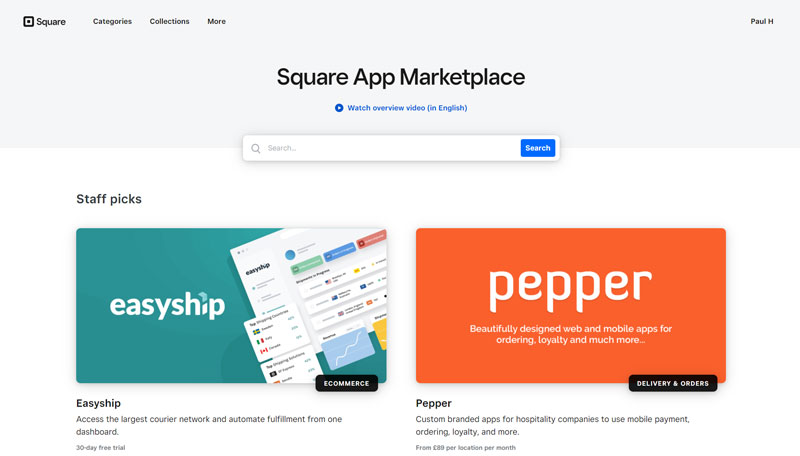
Shopify
As the biggest name in the industry, it is not surprising that Shopify comes with a good selection of features as standard and below is a short summary of what is available:
Ecommerce Tools
- Dropshipping Integration
- Flexible Shipping Rates
- Multi-Language
- Product Reviews
- Digital Products
- Gift Vouchers
- Shopify Management App
Marketing & SEO
- Google Adwords Credit
- Sell on Facebook
- Discount Codes
- Abandoned Cart Recovery
- Auto-Generated Sitemap
- Social Share
- Blog
- Custom Meta Data
- SEO Friendly URLs
Reporting
- Product Reports
- Traffic Sources
- Google Analytics
- Day, Week and Monthly Reports
Payment Gateways
- Shopify Payments
- PayPal Express Checkout
- Amazon Pay
- Klarna
- Worldpay
- Sagepay
If you would like to see a more in-depth breakdown of the features that Shopify has to offer, then check out our full Shopify Review.
Shopify App Store
As you can see Shopify does come with a very good selection of features but due to Shopify allowing third-party developers to develop apps, the amount of features that can be added to a Shopify store is pretty incredible.
To make these apps accessible, Shopify has created its own App Store, which currently has over 3,000 apps available. This selection is a combination of apps made by Shopify and third-party developers.
Unfortunately, not all of these apps are free to use but many offer free trials or packages, if you want access to all of the features, then you are going to have to pay and if you are not careful, it can make Shopify become quite expensive.
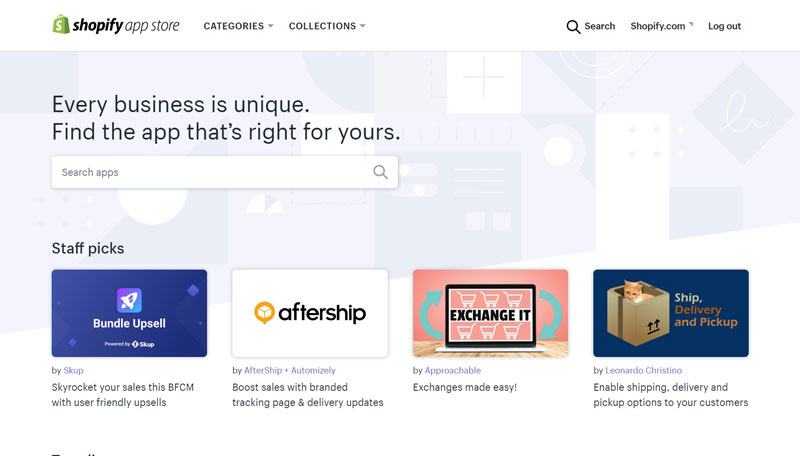
Website Builder
Square
Even though Square is a more budget-friendly option for building an ecommerce website, the website builder is very good as it is based on Weebly (which Square acquired in 2018).
When it comes to theme selection, you don’t get much with Square as they have 1 base theme, which you can then customize to fit your business and brand.
Now this might not seem great but theme customization with Square is very good and there are plenty of options to help you build a good-looking site, this is because the drag-and-drop customizer allows you to:
- Add, remove and rearrange sections
- Customize your header and footer
- Change colors and fonts
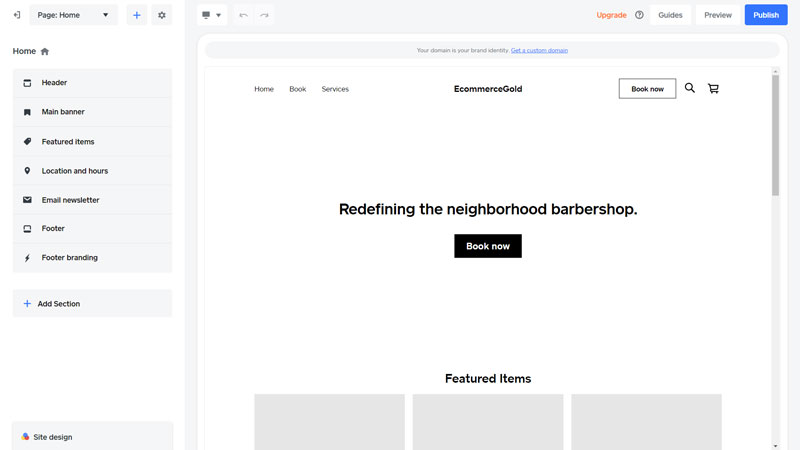
And what makes Squares website builder even better is that it is a full site builder, meaning that you can customize all different page types and create custom pages.
They also have a built-in blog (Square call them stories), which are all created through the customizer and you can add sections to your posts to make them more visually engaging.
There are also SEO options for all of your pages and you can change the URL and add metadata.
Shopify
One of the areas where Shopify has always been one of the industry leaders is its website builder and it is easy to see why.
In terms of theme selection, Shopify offers over 100 free and paid themes (ranging from $200-$350) through its own theme store but there are plenty more available through marketplaces such as ThemeForest and directly from developers.
But it is the theme customization where Shopify truly shines as they include a full, site-wide customizer that allows users to:
- Customize nearly all pages types (only blog posts aren’t included)
- Create custom page templates
- Customize the header and footer
- Change theme settings such as colors and fonts
This gives users a lot of control and even beginners can create beautiful websites using Shopify’s customizer and all changes can be previewed before publishing them to the live site.
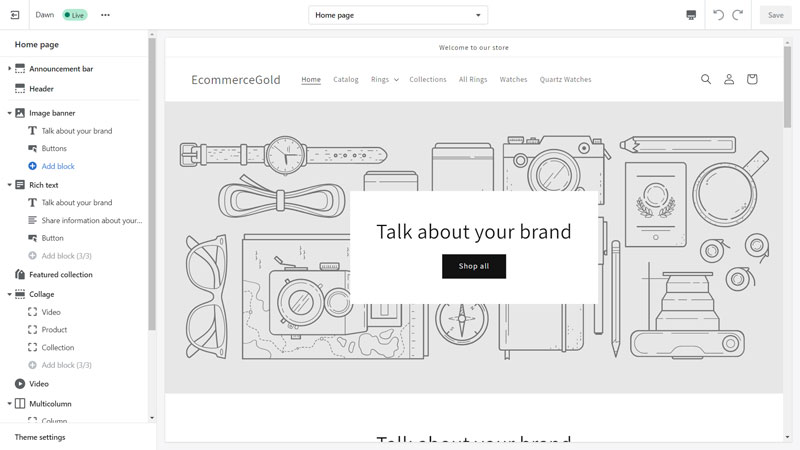
Shopify also lets you create custom pages for your store and these can be basic pages that are created using the text editor or you can create custom page templates using the customizer, which allows you to build pages using all the different sections that are available.
There is also a built-in blog but this is quite basic as it only lets you use the basic text editor, which is a shame as being able to build custom blog posts would be really good and the only way to do this currently is by using an app.
As with Square, all Shopify pages include SEO settings which allow you to customize the URL and set custom metadata.
Support
Running an ecommerce website can be challenging at times and you require some help, so what support do you get from these platforms?
Square
Square offers a range of support options, including:
- Email Support – which aims to get back to you within 48 hours
- Phone Support – available 9 am – 5 pm Monday to Friday
- Community Support Forum
These are available to all users, Square also has some very good help documentation, which covers many of the more common issues that users experience when using Square.
Shopify
Shopify made some changes to their customer support in 2023, with an overhaul of the help center and all support moving to live chat (with the help of an AI chatbot) and email.
This has made contacting their support easier and it is available 24/7, you just have to figure out how to get past the chatbot so that you can speak to a human operator.
They also have a community forum that is frequented by their support staff and other users will also offer help and advice where they can.
Hosting & Performance
Both Square and Shopify provide information about the hosting environment that they use for their websites and they both offer the following:
- PCI Compliant Hosting
- Unlimited Bandwidth
- Unlimited Storage
- Free SSL Certificate
Shopify also offers a global CDN but there was no information about whether this is also the case with Square.
Usually, we put these platform to the test to see how good their hosting is but Square doesn’t have any customer example sites showcased, meaning that they couldn’t be tested properly, if you would like to see how Shopify compares to its competition, then check out our Fastest Ecommerce Platforms post.
Ease of Use
Facts and figures are one thing but what are these platforms like to use and how do they compare to each other? Well, that is what we are going to be looking at in this section.
Getting Started
Square
Getting started with Square isn’t the most straightforward process because when you sign up, you are not just signing up to the ecommerce platform but also the payment gateway and this means there are many more steps in the signup process, which isn’t ideal if you just want to try it out.
Once you have gone through the signup process, you will go through to the main Square dashboard and to access the website builder, you will need to click on the Online Store option, you will then be taken through to the Ecommerce dashboard.
On your first sign-in, you will be greeted by a short setup guide that takes you through the basics of setting up your store including designing your site, creating a product listing and setting up your domain. Overall, a good intro to the platform but a prompt to set up the Terms & Conditions and Privacy Policy would be a good addition.

The dashboard itself is very easy to use as it has a nice, clean interface and the clearly labeled sidebar navigation menu makes it very easy to learn where everything is.
Shopify
Getting started with Shopify is really easy to do, as it is simply a case of going to the Shopify website and entering your email address and creating a password.
Once you have done this, you will be taken to a page where you are asked what stage your business is at such as just getting started or turning over X amount a year along with some other questions. You will then be asked to enter your business information, which is your name, store name and address.
After you have done all this, you will be taken into your dashboard for the first time and be greeted by a short setup guide.
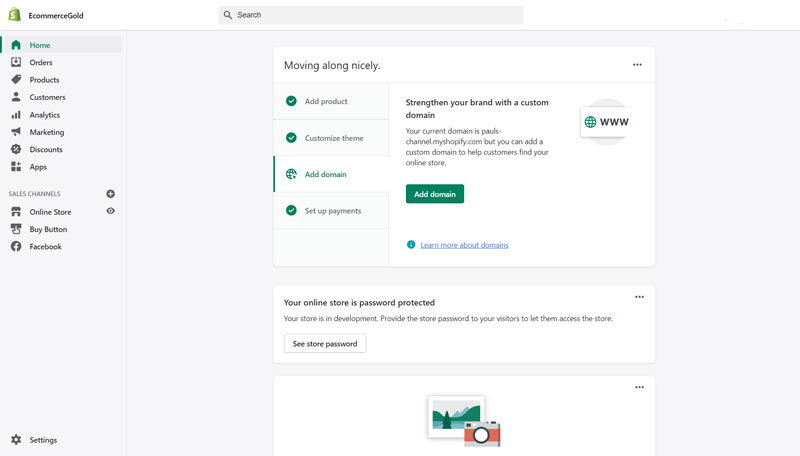
As you can see in the image above, the setup guide doesn’t include that many steps and is missing out on very important ones such as setting up your payment gateway and delivery methods.
Fortunately, they have created a very useful set of videos in their academy, that are worth watching as they not only show you how to get started with Shopify but also include some tips and tricks to get you up and running.
Outside of the setup guide, the Shopify dashboard is a very nice place to be. It has a simple, uncluttered layout and the sidebar navigation menu is clearly labeled, making it very easy to not only find out where everything is within the dashboard but also to move from one section to another.
Managing Your Inventory
Being able to manage your stock efficiently and effectively is a hugely important part of running an online store and there are three main areas to this and they are:
- Adding products
- Organizing your Products
- Managing your inventory
Square
Creating a new product is very simple and easy to do with Square as they have opted for a well-laid-out, single-page layout.
With Square offering many different product types, including Physical, Digital and Membership products, the sections available on the page does depend on the type of product you are creating.
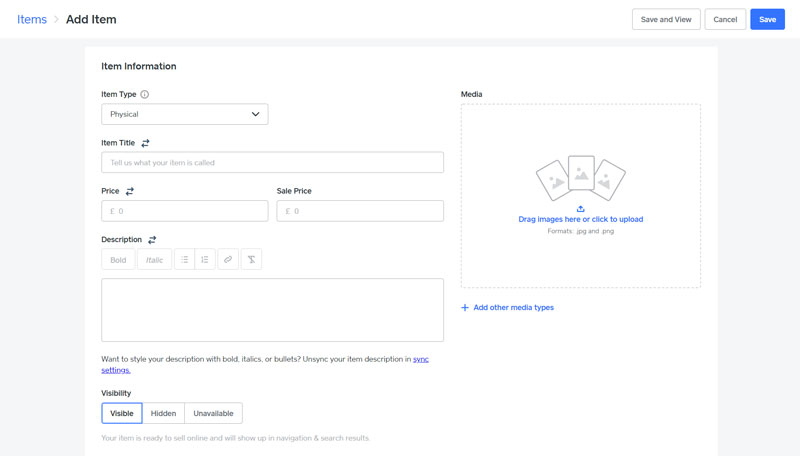
Organizing your inventory is very simple as Square has opted for the traditional category system and you can create main and sub-categories, making it very easy to create a nice, easy-to-use hierarchy for your customers. You can also create multiple sub-categories, which makes this even better.
Managing your inventory isn’t great in Square as they don’t offer any real bulk editors and most changes including stock quantity and price need to be done on a product-by-product basis, which isn’t ideal for large inventories.
Shopify
Adding a new product is really easy to do on the Shopify platform as they have gone for a simple, one-page layout, which has a nice flow from one section to the next. They haven’t gone overboard with the options and you get the right amount of sections to really help sell your product.
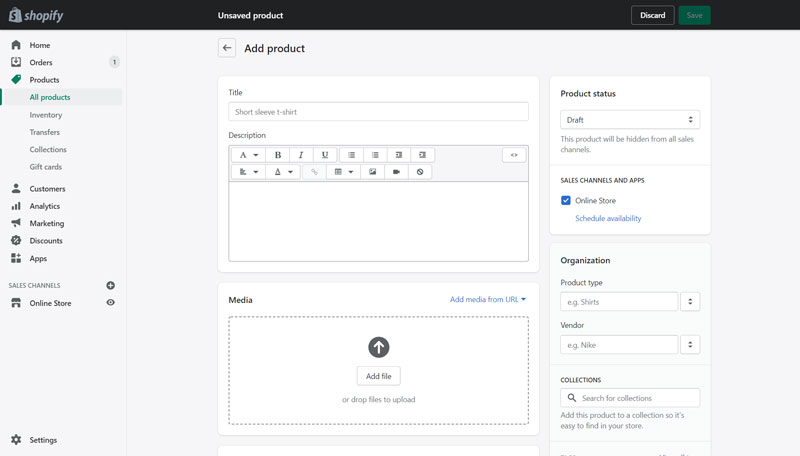
Shopify does things a little differently when it comes to organizing your inventory as they have developed their own collections system and there are a couple of different options on how this can be used:
- Manual Collections – these are collections that you create and then manually add the products to
- Automated Collections – these are a little more complicated as you create rules for the collection and any product that fits these rules are automatically added
The automated collections do take a little more time to understand but can be very effective when used correctly.
One negative with Shopify’s collections is that you can’t create sub-collections, which makes creating a hierarchy for your products a bit more difficult.
Managing your inventory is pretty easy to do in Shopify as they have included an inventory section, that allows you to update your stock quantity in bulk.
There is also a bulk editor that lets you quickly update things like price, title and stock quantity and this editor has filters, which allows you to change many different elements of your product page in bulk.
Managing Orders
Square – Unfortunately, we were unable to test the order management system as we only set up a test environment and didn’t complete the signup process for the Square payment gateway, which meant we couldn’t create a test order.
Shopify – While the order management system in Shopify isn’t bad, it does miss one very useful feature and that is the option to print order invoices in bulk, directly from your order dashboard. The only way that you can add this feature is by installing the Order Printer App, which adds this functionality.
There are some bulk features such as being able to update order statuses and exporting all of your order information in CSV format.
Summary
Square Summary
Square Pros
• Easy to use admin area
• Good theme customizer
• Low Cost
• App integrations
Square Cons
• Limited payment gateways
• No pre-built themes
• Limited bulk editors
Shopify Summary
Shopify Pros
• Theme Customization
• 24/7 Support
• Easy to use Admin Area
• The App Store
Shopify Cons
• Transaction Fees
• Automatic Collection system is a bit complicated
• No option to bulk print invoices
Conclusion
Square vs Shopify – Which one is the Best Ecommerce Platform?
Shopify comes out on top between these two platforms as it offers a better all round and also scalable package than Square.
This is because Shopify performs well in all areas, from features and add-ons to ease of use and theme customization, it is just a very good ecommerce platform. Now it isn’t perfect as it is more expensive than Square in terms of subscription costs and the transaction fee but neither of these massively detract from Shopify.
Now Square is a good ecommerce platform and could be a good option for smaller businesses or ones already using the Square POS but it does have a couple of drawbacks, the biggest being the very limited payment gateway options and the second being the lack of bulk editors but it is still worth considering for a small business, especially if you already use the Square POS.
So there it is, our complete comparison between these two ecommerce platforms and as with all business decisions, it comes down to what YOU and YOUR business requires and we recommend trying them both before choosing which on to use for your ecommerce business.

EcommerceGold Score


EcommerceGold Score
Other Comparisons
Hi, I'm Paul, the Owner and Founder of EcommerceGold.
I ran my own Ecommerce Business for over 7 years and now help others start their own online retail empires!

